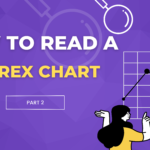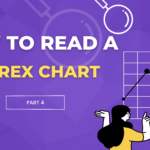MACD (Moving Average Convergence Divergence)This popular oscillator measures the difference between two exponential moving averages to identify trend direction and strength. Signal line crossovers of the MACD line signal trend changes.Properly interpreting indicators within the context of the price chart can provide valuable insight into the market’s psychology. Traders must understand how each indicator works …
How to Read a Forex Chart: Part 3 of 4

MACD (Moving Average Convergence Divergence)
This popular oscillator measures the difference between two exponential moving averages to identify trend direction and strength. Signal line crossovers of the MACD line signal trend changes.
Properly interpreting indicators within the context of the price chart can provide valuable insight into the market’s psychology. Traders must understand how each indicator works to avoid false signals.
Identifying Trends
The overall direction of prices over weeks or months is known as the trend. There are three main trends:
Uptrend
An uptrend refers to the overall direction of prices rising over time. For a currency pair to be classified as trending higher, it must make a series of successively higher highs and higher lows on the chart. This shows buyers are consistently overpowering sellers at lower levels, driving the market up.
On a chart, traders can visually identify an uptrend by drawing trendlines connecting the successive swing highs and lows. The trendline should angle up to the right to reflect the higher highs and lows. The steeper the trendline, the stronger the trend.
Within an uptrend, traders look to buy pullbacks toward trendline support or other identified support levels like the 20-day moving average. Stops are placed below swing lows, with targets based on technical indicators like Fibonacci extensions or flat resistance levels.
Uptrends persist as long as higher highs and lows continue. The trend is invalidated if prices close below the trendline or major support level on higher volume, signaling sellers are now dominating. This would be a trend reversal point to consider shorting.
Downtrend
A downtrend is the opposite of an uptrend, with prices declining over an extended period. For a downtrend to be in effect, the currency pair must form a series of successively lower highs and lower lows on the chart.
On a visual level, this shows sellers are consistently overpowering buyers at higher levels, driving the market downward. Traders draw downtrend lines connecting the lower highs and lows, which angle down to the right to reflect the bearish price action.
Within a downtrend, traders look for opportunities to short rallies toward the trendline resistance or moving averages like the 20-day. Stops are placed above swing highs, with targets at support levels.
The downtrend is considered intact as long as the lower highs and lows persist. It is negated if prices close above the downtrend line on strong volume, invalidating the bearish trend and potentially signaling a reversal to the upside. This would offer a point to cover short trades.








